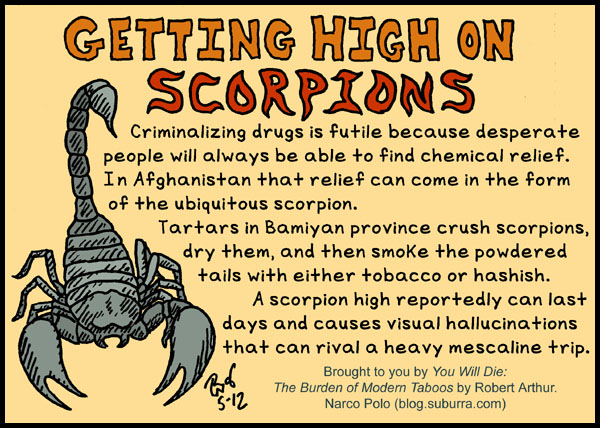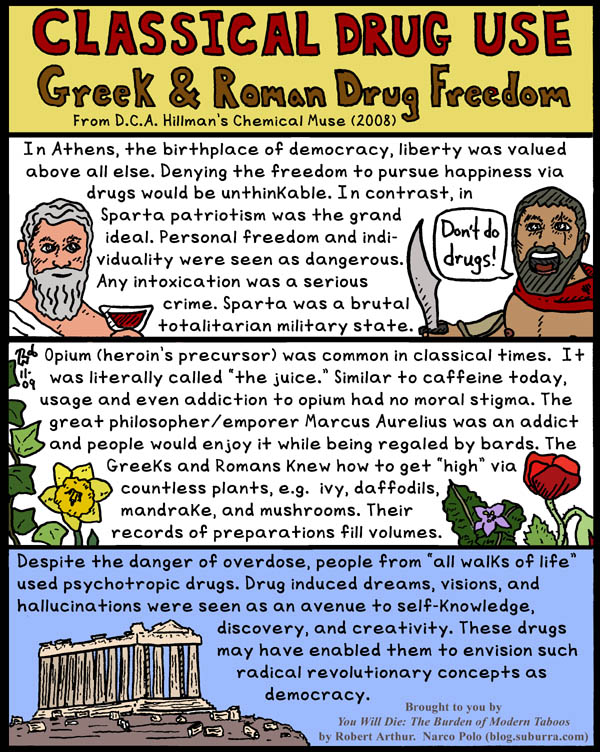Posted: June 4th, 2012 | Filed under: bath salts, cocaine, drugs, hallucinogens, LSD, marijuana, media bias | 5 Comments »

(For more information on bath salts read “Doctor Tried Bath Salts and Liked It: In Defense of Bath Salts,” or learn about the “Legal Drug Linked to More Cannibalism than Bath Salts.”)
On May 26, 2012, a naked Rudy Eugene ate the face of Ronald Poppo by a Miami causeway. Despite there being no evidence of drug use, yellow journalism used the specious speculation of Miami’s police union president to launch an avalanche of errant drug bashing.
The truth is that drug abuse/dependence is not a statistically significant predictor of violence, nor is severe mental illness. (Eugene was young, male, and had a history of violence – the top three predictors.) Drug use and severe mental illness are only significantly problematic when coupled with violent tendencies. (2,5)
Eugene clearly had anger and violence issues. In 2004 he became the first person to be Tased in North Miami Beach when he went on a destructive rampage in his mother’s home. He shoved her, broke a table, smashed items, and told her, “I’ll put a gun to your head and kill you.” When the police arrived he threatened them as well. (3)
Contrary to media presentations, it appears Eugene did not take bath salts, LSD, or cocaine. According to his girlfriend he frequently used marijuana but refused all other drugs. He even avoided medication for minor ailments like headaches.
Two days before the attack Eugene and two friends had a Bible study where they discussed how to become better men according to the word of God. Eugene vowed to give up marijuana. It is more likely that this vow – not bath salts – precipitated the attack.
A 1985 Kent State study found that administrating a moderate to heavy amount of marijuana promotes non-aggression. (4) Although understudied, marijuana’s pacifying effects are obvious to users. A 2007 Danish study of over a hundred marijuana smokers in dependence treatment found that more of them used marijuana to relax (86%) than to get “high” (82%), and nearly half of them smoked marijuana to decrease aggression. (1)
It is highly probable that a more relaxed and less aggressive Eugene would have behaved differently on that causeway.
Note: If toxicology reports come back positive for marijuana it does not mean that Eugene was partaking. Heavy marijuana users can test positive for marijuana for up to a month after their last use.
Tip of the Hat
I salute the following journalists for writing articles criticizing the fallacious and narcophobic coverage of the Causeway Cannibal:
1. Kristen Gwynne, “Dumb and Dangerous Anti-Drug Propaganda in the Miami Zombie Story,” AlterNet.org. 31 May 2012. LINK
2. Jacob Sullum, “If You Use Drugs, You Might End Up Eating Someone’s Face,” Reason.com, 29 May 2012. LINK
3. Maia Szalavitz, “Why Drugs Are Getting a Bum Rap in the Miami Face-Eating Attack,” Time.com, 30 May 2012. LINK
Addendum (June 28, 2012) – The full toxicology report of Rudy Eugene released on June 27, 2012 reported that the only drug found in his body was marijuana. The common chemicals in drugs sold as bath salts were absent. LINK
Sources
1. Mikkel Arendt, et al., “Testing the Self-Medication Hypothesis of Depression and Aggression ….,” Psychol. Med., 2007, 37.
2. Eric Elbogen & Sally Johnson, “Intricate Link Between Violence and Mental Disorder,” Arch. Gen. Psychiatry, Feb. 2009.
3. Gus Garcia-Roberts, “Rudy Eugene to Mother in 2004 ….,” MiamiNewTimes.com, 30 May 2012.
4. Rodney Myerscough & Stuart Taylor, “Effects of Marijuana on Human Physical Aggression,” J. Pers. Soc. Psychol., 1985, 49(6).
5. Rick Nauert, “Mental Illness Does Not Predict Violence,” PsychCentral.com, 26 Feb. 2009.
Posted: May 10th, 2012 | Filed under: drugs, hallucinogens, marijuana, opiates | 13 Comments »

David Macdonald argues in his 2007 book, Drugs in Afghanistan, that Afghanistan’s increased drug usage is driven by an impoverished battle-scarred population trying desperately to relieve its suffering.* Western-led efforts to universally criminalize drugs are futile because distressed people will always be able to find chemical relief.
As an example, Macdonald notes that in Afghanistan even the ubiquitous scorpions can be used for intoxication. Tartars in Bamiyan province prepare scorpions by smashing them between stones and letting them dry. The main part of the tail, with the sting, is then crushed into a powder and smoked with tobacco and/or hashish (marijuana).
A friend of Macdonald’s who witnessed a man smoke scorpion in the Afghan town of Peshawar described the reaction:
The effect was instantaneous with the man’s face and eyes becoming very red, “much more than a hashish smoker” …. He also seemed very intoxicated but awake and alert, although he stumbled and fell over when he tried to rise from a sitting position …. the smoke tasted “sweeter” than that of hashish, although … it smelled foul, and the intoxicating effect lasted much longer. (1, p. 247)
As with most drugs, anecdotal reports of scorpion’s effects vary widely. It is likely that the numerous Afghan scorpion species have divergent psychoactive properties. Scorpion has been reported to keep one awake, cause severe headaches, and rival the effects of a “strong mescaline trip.” (1, p. 248) One Kabul man who had smoked between 20 and 30 times reported the effects to last three days. During these periods he had difficulty opening his eyes, his head spun, and he had constant visual hallucinations.
Globally, scorpion smoking is still rare. The failure of the war on other drugs has not driven people to seek it out … yet. If drug war success sparking scorpion use sounds unbelievable, in India’s Western states police crackdowns on mainstream illicit drugs have already led to “sting sellers.” A police officer in the city of Bharuch said:
Because of our successful drives against the sellers and addicts of alcohol, opium, cough syrup, and heroin in urban areas, young people are flocking on the highways to try the new craze of scorpion stings. (2)
The futility of drug criminalization may become comically clear if more drug war “victories” bring about a war on arachnids.
* Macdonald is a sociologist who has specialized in drug control for over 20 years. From 1999 until his book’s publication in 2007 he served as the demand reduction adviser for the UN drugs control program in Afghanistan with UNODC and also with the Ministry of Counter Narcotics in Kabul.
Sources
1. David Macdonald, Drugs in Afghanistan: Opium, Outlaws, and Scorpion Tales (2007). LINK
2. “New Drugs Craze Has a Scorpion Sting in the Tail,” Scotsman.com, 25 Apr. 2004. LINK
Posted: November 16th, 2009 | Filed under: alcohol, drugs, hallucinogens, heroin, history, legalization, mushrooms, opiates | 12 Comments »

As Dr. David Hillman writes in his book, The Chemical Muse (2008):
The Greeks and Romans used opium, anticholinergics, and numerous botanical toxins to induce states of mental euphoria, create hallucinations, and alter their own consciousness; this is an indisputable fact. (p. 87)
This fact has been intentionally ignored and covered up by historians. (See previous post.) Recreational drugs have been translated out of classical literature in the same manner as bawdy sexual references were until recent decades.
This has occurred with individual words. Opium has been translated into poppy seeds even where it makes no sense. But it has also occurred with entire concepts.
Drugs, Sex, Magic
Classical literature abounds with sorcerers, magicians, and witches. Translators rarely reveal that their power stemmed from their great expertise in drugs. Sorcerers were classical drug dealers and the effects of drugs were seen as magical in those times. Drugs and magic were one.
Medea, the wife of Jason the Argonaut, is frequently portrayed as a witch. She aided Jason by putting fire-breathing bulls asleep and giving him amazing courage. Hillman shows how translators mistranslate polypharmakon and pharmaka to present her as being skilled in the “magical arts” and a possessor of “charms.” Medea was actually “drug-savvy” and possessed “drugs.” She gave the bulls and Jason drugs, not spells.
Sorcerers were honored and respected members of society. They and the more run-of-the-mill drug sellers, “root cutters,” had to know how to extract desired chemicals from plants and animals. This was an exact science for the wrong amount or the wrong extraction could kill. For example, mandrake in minute doses could generate euphoria and stimulate libido, at low doses it was an anesthetic, and at regular doses it was lethal.
Symposia and Spiked Wine
The Greeks and Romans favored method of drug administration was to mix them with wine. This has allowed history teachers to present ancient revelers as merely drinkers – not “illegal drug” users. As the scholar, Dr. Carl A.P. Ruck has written:
Ancient wine, like the wine of most early peoples, did not contain alcohol as its sole inebrient but was ordinarily a variable infusion of herbal toxins in a vinous liquid. Unguents, spices, and herbs, all with recognized psychotropic properties, could be added to the wine. (pp. 176-177)
This gives an entirely different purview of the Greek symposia. At these “riotous drinking parties” great minds like Socrates and Plato debated and developed their theories on the great philosophical questions. Another clue tells even more. Altered states of consciousness were viewed as divinely provided madness. Plato wrote:
But he who without divine madness comes to the doors of the Muses, confident that he will be a good poet by art, meets with no success, and the poetry of the sane man vanishes into nothingness before that of the inspired madmen. (p. 177)
To learn about the academic censorship of this scholarship read, “The Ph.D. Candidate Who Said Too Much: A Drug History Whitewash.”
Source:
D.C.A. Hillman, The Chemical Muse: Drug Use and the Roots of Western Civilization (2008). LINK





